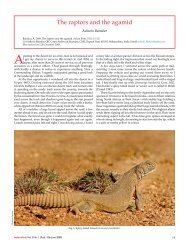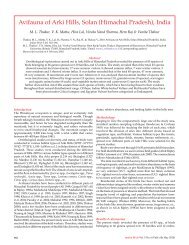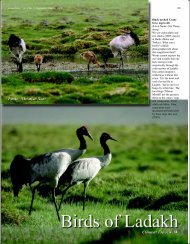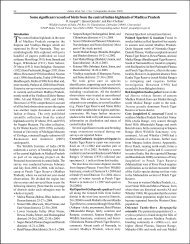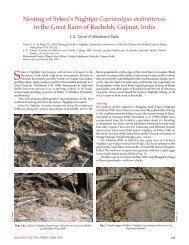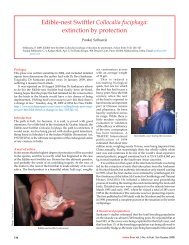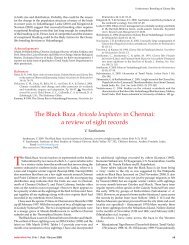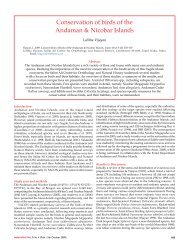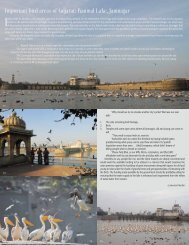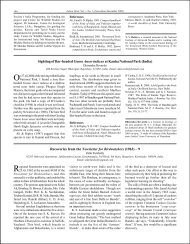Birds of Sirumalai, Tamil Nadu: 1980â2009 - Indian Birds
Birds of Sirumalai, Tamil Nadu: 1980â2009 - Indian Birds
Birds of Sirumalai, Tamil Nadu: 1980â2009 - Indian Birds
- No tags were found...
You also want an ePaper? Increase the reach of your titles
YUMPU automatically turns print PDFs into web optimized ePapers that Google loves.
<strong>Birds</strong> <strong>of</strong> <strong>Sirumalai</strong>, <strong>Tamil</strong> <strong>Nadu</strong>: 1980–2009Kevan BundellBundell, K. 2010. <strong>Birds</strong> <strong>of</strong> <strong>Sirumalai</strong>, <strong>Tamil</strong> <strong>Nadu</strong>: 1980–2009. <strong>Indian</strong> <strong>Birds</strong> 5 (5): 143–145.Kevan Bundell, Tanglewood, Outlands Lane, Curdridge, Southampton SO30 2HD, United Kingdom. Email: kbundell@yahoo.co.ukManuscript received on 21 March 2009.IntroductionThis paper reports the birds observed in <strong>Sirumalai</strong> (Little Hills) inthe Dindigul district <strong>of</strong> <strong>Tamil</strong>nadu by the author in the years 1980,and 2009. It includes observations reported by Swami (2006), andadditional reports by local informants to the author in 2009. It alsomakes reference to a list <strong>of</strong> the birds <strong>of</strong> the Palani Hills publishedby the Palani Hills Birdwatchers Society 1 .The author was privileged to stay in the village <strong>of</strong> <strong>Sirumalai</strong>Palaiyur for a period <strong>of</strong> eight months, from January to August, in1980, and to return for a period <strong>of</strong> five days in January 2009.In geological terms it would seem that <strong>Sirumalai</strong> is one <strong>of</strong> thesouthernmost outposts <strong>of</strong> the Eastern Ghats. 2 However, in terms <strong>of</strong>its location, it is close to the Western Ghats, and more particularlyto the spur <strong>of</strong> the Palani Hills, from which it is separated at thenarrowest point by a distance <strong>of</strong> only 12 km or so. Although<strong>Sirumalai</strong> has been studied in some detail in terms <strong>of</strong> its flora(Pallithanam, 2001; Karuppusamy et al. 1999; Kottaimuthu et al.2008), there seems to be little <strong>of</strong> substance published on its faunain general or, other than Swami (2006), on its birds in particular.<strong>Sirumalai</strong> lies to the north <strong>of</strong> Madurai, and to the south <strong>of</strong>Dindigul. The surrounding plain lies at an average height <strong>of</strong> about300 m. <strong>Sirumalai</strong>, roughly speaking, consists <strong>of</strong> an outer ring <strong>of</strong>hills at an average height <strong>of</strong> about 1,000 m, though with a number<strong>of</strong> peaks exceeding 1,350 m, and a central bowl at about 700 m. Thehills rise more or less abruptly from the plain in the north, west,and south while tapering away into low hills to the east. Much<strong>of</strong> the hills are reserved forest, including areas <strong>of</strong> more or lessnatural dry evergreen and semi-evergreen forest; some is c<strong>of</strong>fee,and other plantation, <strong>of</strong>ten with mature, planted tree cover; andthe remainder is cultivated by local smallholder agriculturalists orlarger landowners. Three main streams run through the hills, anddown to the plains. <strong>Sirumalai</strong> receives its only significant rainfallbetween October and December with the NE Monsoon.Environmental changes: 1980–2009There has been a noticeable increase in forest cover in <strong>Sirumalai</strong>since 1980, particularly in the interior. This is despite some recentclearance for new farms, including for the growing <strong>of</strong> cut flowers.This increase is presumably at least partly the result <strong>of</strong> the efforts<strong>of</strong> the forest department. It is certainly the case that timber is nolonger being extracted by the lorry-load, <strong>of</strong>ten illegally, to theextent it was in 1980. It may also be due in part to older smallholdings, many <strong>of</strong> which were recently cleared in 1980, now havingmore trees, both for fruits, and to provide shelter for growingc<strong>of</strong>fee. The arrival <strong>of</strong> a viral disease <strong>of</strong> bananas in the late 1980sor early 1990s may also have contributed. <strong>Sirumalai</strong> is locally wellknown for its small, sweet hill bananas, which were grown bothby smallholders and in monocrop plantations. Unlike c<strong>of</strong>fee, thebananas do not require shade, and their cultivation therefore led toclearing <strong>of</strong> forest, and scrub. However, banana cultivation is nowmuch reduced. There has also been an increase in forest cover onthe Northern-most slopes <strong>of</strong> <strong>Sirumalai</strong>, where the only road intothe hills winds up from the plains South <strong>of</strong> Dindigul. However,the remaining outer slopes <strong>of</strong> the hills remain semi-denuded asa result <strong>of</strong> firewood collecting by people from the surroundingvillages on the plains.Identification, naming & listingIn the table below, a full list <strong>of</strong> the birds <strong>of</strong> <strong>Sirumalai</strong>, both, reportedby others, and observed by myself, is given in the first column,following Manakadan & Pittie (2002). The additional columnsrequire further explanation:When I arrived in <strong>Sirumalai</strong> in January 1980, on my first visitto India, from the UK, I was a reasonably experienced birdwatcherin terms <strong>of</strong> UK birds, but I had no illustrated field guide to <strong>Indian</strong>birds to assist me with this, to me, new avifauna. Indeed nomodern field guide existed at that time and I was not aware <strong>of</strong>Salim Ali’s The book <strong>of</strong> <strong>Indian</strong> birds, any edition <strong>of</strong> which would atleast have got me started. I did find a copy <strong>of</strong> Baker & Inglis (1930),but this was hardly illustrated, and was as keen to advise on howto shoot the birds as to help identify them! However, in April 1980a copy <strong>of</strong> the then recently published Collins Handguide to the <strong>Birds</strong><strong>of</strong> the <strong>Indian</strong> Sub-Continent (Woodcock 1980) arrived in the post,sent by a friend for my birthday from the UK. I mention all thisbecause, combined with having other work to do on first arrivalin <strong>Sirumalai</strong>, it meant that I did not start seriously identifying thebirds I was seeing until April, and I therefore missed most <strong>of</strong> thebirds that were winter visitors to the area. In 2009 I deliberatelychose to visit during winter. These facts are reflected in the birdsobserved, as shown below.In January 2009 I used Grimmett & Inskipp (2005) as myfield guide.The fifth column lists those birds that are not listed underSwami (2006), nor seen by me. They were identified by two local,adult, informants 3 to whom I showed the illustrations in Grimmett& Inskipp (2005). One would not normally rely on identificationsby non-‘expert’ observers, and indeed a few identifications madewere clearly erroneous, for example, the Red Junglefowl Gallusgallus. (Another informant, an experienced hunter, confirmed thatthis was not correct). However, in view <strong>of</strong> the paucity <strong>of</strong> reportedobservations <strong>of</strong> the birds <strong>of</strong> <strong>Sirumalai</strong> I have considered it worthincluding these here.With my own observations, I have indicated with a questionmark where identification was uncertain.Winter visitors are indicated thus: (W).1 http://phbws.org/bph.html; accessed 8 April 2009.2 http://www.ecoindia.com/ghats/eastern.html.3 Sri B Parthasarathy <strong>of</strong> <strong>Sirumalai</strong> Palaiyur, and Sri G Sethuraj <strong>of</strong> <strong>Sirumalai</strong>Podur.<strong>Indian</strong> <strong>Birds</strong> Vol. 5 No. 5 (Publ. 5 April 2010) 143
Bundell: <strong>Birds</strong> <strong>of</strong> <strong>Sirumalai</strong>Species<strong>Indian</strong> Pond-Heron Ardeola grayiiOriental Honey-buzzard Pernis ptilorhynchusBlack-shouldered Kite Elanus caeruleusCrested Serpent-Eagle Spilornis cheelaShikra Accipiter badiusTable: <strong>Birds</strong> <strong>of</strong> <strong>Sirumalai</strong>, observed and/or reported 1980 - 2009BundellJan–August 1980SSwami (2006)Black Eagle Ictinaetus malayensis S S SMountain Hawk-Eagle Spizaetus nipalensisCommon Kestrel Falco tinnunculusGrey Junglefowl Gallus sonneratii<strong>Indian</strong> Peafowl Pavo cristatusEmerald Dove Chalcophaps indicaMountain Imperial-Pigeon Ducula badiaRose-ringed Parakeet Psittacula krameriBlossom-headed Parakeet Psittacula cyanocephalaBlue-winged Parakeet Psittacula columboides S SLarge Green-billed Malkoha Phaenicophaeus tristisGreater Coucal Centropus sinensisMottled Wood Owl Strix ocellataCeylon Frogmouth Batrachostomus moniligerGreat Eared-Nightjar Eurostopodus macrotisWhite-breasted Kingfisher Halcyon smyrnensisChestnut-headed Bee-eater Merops leschenaultiHoopoe Upupa epops S SBrown-headed Barbet Megalaima zeylanica S SWhite-cheeked Barbet M. viridis S SSSSSSSBundellJan 2009Coppersmith Barbet M. haemacephala S SCommon? / Lesser Golden-backed WoodpeckerDinopium javanense / benghalenseSSHeart-spotted Woodpecker Hemicircus canente<strong>Indian</strong> Pitta Pitta brachyuraCommon Swallow Hirundo rustica (W)SLarge Pied Wagtail Motacilla maderaspatensisGrey Wagtail Motacilla cinerea (W)SScarlet Minivet Pericrocotus flammeus S SCommon Woodshrike Tephrodornis pondicerianus S SRed-whiskered Bulbul Pycnonotus jocosus S SRed-vented Bulbul P. cafer S SAsian Fairy Bluebird Irena puella S SMalabar Whistling-Thrush Myiophonus horsfieldiiSOrange-headed Thrush Zoothera citrinaSOriental Magpie Robin Copsychus saularis S SWhite-rumped Shama C. malabaricus<strong>Indian</strong> Robin Saxicoloides fulicataS<strong>Indian</strong> Scimitar-Babbler Pomatorhinus horsfieldiiSJungle Babbler Turdoides Striatus S SCommon Tailorbird Orthotomus sutoriusGreenish Warbler? Phylloscopus trochiloides (W)SNilgiri Flycatcher Eumyias albicaudataSGrey-headed Flycatcher Culicicapa ceylonensis (W)SSSSSSSSParthasarthy & SethurajJan 2009SSSSSSSSSSS144<strong>Indian</strong> <strong>Birds</strong> Vol. 5 No. 5 (Publ. 5 April 2010)
Bundell: <strong>Birds</strong> <strong>of</strong> <strong>Sirumalai</strong>Asian Paradise Flycatcher Terpsiphone paradisi S SGreat Tit Parus major S SVelvet-fronted Nuthatch Sitta frontalis S SPurple-rumped Sunbird Nectarinia zeylonicaOriental White-eye Zosterops palpebrosaWhite-throated Munia Lonchura malabaricaSpotted Munia L. punctulata S SBlack-headed Munia L. malaccaCommon Myna Acridotheres tristisBlack-headed Oriole Oriolus xanthornusBlack Drongo Dicrurus macrocercus S SBronzed Drongo? D. aeneusSpeciesGreater Racket-tailed Drongo D. paradiseus S SAshy Woodswallow Artamus fuscus<strong>Indian</strong> Tree Pie Dendrocitta vagabunda S SHouse Crow Corvus splendensJungle Crow C. macrorhynchosTable: <strong>Birds</strong> <strong>of</strong> <strong>Sirumalai</strong>, observed and/or reported 1980 - 2009BundellJan–August 1980SSSwami (2006)SBundellJan 2009SSSSSParthasarthy & SethurajJan 2009SSComments and comparison: 1980–2009As an indicator <strong>of</strong> confidence in the above observations it may bementioned that all but three <strong>of</strong> the species listed above, includingall those locally reported, also appear in the list <strong>of</strong> birds <strong>of</strong> thePalani Hills published by the Palani Hills Birdwatchers Society.This list covers the neighbouring upper and lower Palani Hillsbut does not include observations from <strong>Sirumalai</strong> 4 . The threespecies not mentioned are the Ceylon Frogmouth Batrachostomusmoniliger, the Great Eared-Nightjar Eurostopodus macrotis, andthe Mountain Hawk-Eagle Spizaetus nipalensis, listed by Swami(2006)—all <strong>of</strong> which could be difficult to distinguish from similarspecies, which are listed (e.g., the latter from the Oriental HoneybuzzardPernis ptilorhynchus).The Malabar Parakeet Psittacula columboides and the NilgiriFlycatcher Eumyias albicaudata – reported by Swami - are endemicto the Western Ghats 5 . This emphasises the avifaunal, if notgeological, affinity <strong>of</strong> <strong>Sirumalai</strong> to this range rather than to theEastern Ghats.Unsurprisingly both, House Corvus splendens, and Large-billedC. macrorhynchos Crows are present in <strong>Sirumalai</strong>. However, in 1980there were apparently no crows in the hills, and certainly none inor around the main settlements. This was not only observably truebut was also well known to the local people, who held that it wouldbe inauspicious, should a crow appear. Crows <strong>of</strong> both species were<strong>of</strong> course common on the surrounding plains at that time.This is clearly not a complete list <strong>of</strong> the birds to be found in<strong>Sirumalai</strong>. Other than where indicated, my own observations arerestricted to what I could confidently identify, so that, for example,I have omitted the swifts and martins, which accompanied theCommon Swallows daily during my visit in 2009.In other words, more work remains to be done.MammalsAlthough this is an article on the birds <strong>of</strong> <strong>Sirumalai</strong> (in a journaldevoted to birds), given the paucity <strong>of</strong> available informationon the fauna <strong>of</strong> these hills in general, it would seem remiss notto mention the animals observed, although most have beenpreviously reported.<strong>Sirumalai</strong> is well known as a home <strong>of</strong> the endangered SlenderLoris Loris tardigradus lydekkerianus 6 , which I did not observe,but was reported to me by local informants in 1980. However, in2009 I did observe another endangered species, which is knownto be present in <strong>Sirumalai</strong>, the Grizzled Giant Squirrel Ratufamacroura 7 .In 1980 I also observed Common Langur Presbytis entellus,Bonnet Macaque Macaca radiata, and <strong>Indian</strong> Porcupine Hystrixindica, and in 2009, Bonnet Macaque again, as well as Gaur Bosgaurus.ReferencesAli, S. The book <strong>of</strong> India birds. Bombay: B.H.N.S.Baker, H. R. & Inglis, C. M., 1930. The birds <strong>of</strong> southern India. Madras:Government Press.Grimmet, R., & Inskipp, T., 2005. <strong>Birds</strong> <strong>of</strong> southern India. London:Christopher Helm / A & C Black.Kottaimuthu, R., Ganesan, R., Ganesan V., & Sundaram, V. M., 2008.Enumeration <strong>of</strong> orchids <strong>of</strong> <strong>Sirumalai</strong> Hills (Eastern Ghats), <strong>Tamil</strong><strong>Nadu</strong>, India. Ethnobotanical Leaflets 12: 506–512. 2008.Karuppusamy, S., Rajasekaran, K. M., & Kumuthakalavalli, R., 1999.Orchids <strong>of</strong> <strong>Sirumalai</strong> Hills. J. Swamy Bot. 16: 73–74.Manakadan, R. & Pittie, A. 2002. Standardised common and scientificnames <strong>of</strong> the birds <strong>of</strong> the <strong>Indian</strong> Subcontinent. Newsletter forBirdwatchers 42 (3): 1+i–viii, 1–36.Swami, V. N. 2006. <strong>Birds</strong> <strong>of</strong> <strong>Sirumalai</strong>, <strong>Tamil</strong> <strong>Nadu</strong>. <strong>Indian</strong> <strong>Birds</strong> 2 (1):16–17.Pallithanam, J. M. 2001. A pocket flora <strong>of</strong> the <strong>Sirumalai</strong> Hills, South India.Tiruchirapalli: The Rapinat Herbarium.Vikneshwaran D., Viji, M., & Lakshmi, K. R., 2008. A survey <strong>of</strong> theethnomedicinal flora <strong>of</strong> the <strong>Sirumalai</strong> Hills, Dindigul district, India.Ethnobotanical Leaflets 12: 948-53. 2008.Woodcock, M., 1980. Collins handguide to the birds <strong>of</strong> the <strong>Indian</strong> Sub-continent.London: Collins.4 Dr A David Ravindran, PHBWS President, personal communication.5 BirdLife EBA Factsheet 123, Western Ghats http://www.birdlife.org/datazone/ebas/index.html?action=EbaHTMDetails.asp&sid=125&m=06 http://dindigul.nic.in/forest.htm7 ibid<strong>Indian</strong> <strong>Birds</strong> Vol. 5 No. 5 (Publ. 5 April 2010) 145



